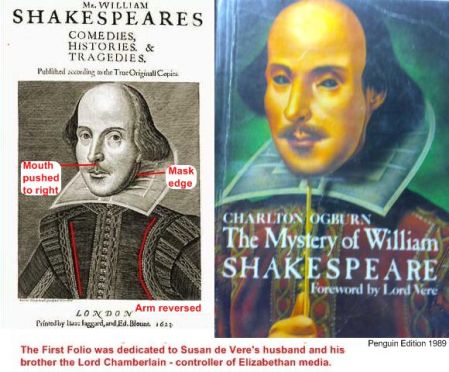z Shake-scene = Theatre-scene
Note: this the 19v10 Wikipedia draft
_____________________
Shake-scene = Theatre-scene
Mark Anderson has noted, there may not be a smoking gun pointing directly to Edward de Vere but it’s just like mounting circumstantial evidence can convict someone in a court of law.
For instance, the Droeshout mask which can be seen clearly on the First Folio 1623 cover, but is suspiciously obscured with shading in later reproductions.
Then there is the ‘notorious hyphen’ in the often printed “Shake-speare” and the link to the Elizabethan understanding of Pallas Athena (Minerva) goddess of wisdom – ‘shake a speare at ignorance’ (using a lance-shaped pen – ‘the pen is mightier than the sword’).
Thus shake-scene = theatre-scene.
Yet just like the Droeshout reproductions, the hyphen is often ‘forgotten’ by orthodox scholars, like the reference to John Davies’ Scourge of Folly and his ‘English Terence’ line <!–by Stanley Wells or Taylor, who states the idea of Vere as being absurd–>).
Vanessa Redgrave noted in the press con that we have trouble comprehending how different things were back then – Elizabethan English was closer to modernday American. The first usage of the word ‘theatre’ (previously it had been ‘ampitheatre’) dates back to 1576 with the building of first theatre for the commoner, aptly called “The Theatre”.
Edward de Vere returned from his ‘tour’ of the European (he seems to have slipped away after a falling out with Elizabeth at around the time of the birth of Southampton) entertainment scene in 1576. He then lived nearby in Fishers Folly of Bishopsgate .
He also had the early lease on the exclusive Blackfriars theatre down town.
Around him Oxford gathered his personal secretaries and hangers on, including: John Lyly (Euphuism), Anthony Munday (Robin Hood), Robert Greene, Thomas Kyd, Thomas Watson (who brought along a young Christopher Marlowe), and Thomas Nashe (many of them strangley went quiet at about the same time he sold ‘Sidextra’). It was a time when authors were not celebrities, many works were “anonymous” – it was uncouth for nobleman to sink to putting their names on plays and anyone linked to writing anything exposing folly was persecuted, any such evidence had to be destroyed. And just like in modern Hollywood many writers worked on a script, uncredited (even long after it has played and is then published, like Mary Sidney, who like de Vere had family links and estates in the Stratford area .
So commoners around them were paid off as frontmen, Ogburn and later scholars like Hopkins Hughes (creator of the ‘Politic Worm’ site) link Edward de Vere also to the Arthur Brooke (The Tragical History of Romeus and Juliet, 1562), Thomas Kyd’s (Spanish Tragedy and Ur-Hamlet), and Francis Bacon to Thomas Nashe. Thus explaining why orthodox scholars are force to accept the great playwright rarely creating original work, but constantly reworking (plagiarizing even) older plays of others, when like all writers over centuries, Edward de Vere was reworking his own plays.
The problem becomes not that his works were edited (probably by Mary Sidney and Francis Bacon) after his death in 1604 for publication in the First Folio, but that many of Shake-speare’s works are based on earlier plays written when Shakspere would have been a teenager.
In the 1592 Groatsworth of Wit by Robert Greene. In contrast, Stratfordians take the obscure allusions to the upstart crow, shake-scene, and ‘O tiger’s heart wrapped in a woman’s hide’, Henry VI Part III: 1.4.137 – as the first printed reference to idea of William Shakspere as the great playwright. Many like Daryl Pinksen have shown the ‘upstart crow’ (a rant which Greene had included in earlier works) more likely refers to Edward Alleyn, who was the actor speaking the lines in the play at the time, and married to Henslowe’s (famous impresario) daughter.
Ogburn, Anderson et al, note too that the Henry VI play overly promotes in an anachronistic way Edward de Vere’s ancestor 13th Earl of Oxford (the oldest peerage in England).
There is no such comparative record of the movements of William Shakspere. There’s his Will that doesn’t mention plays or reference books, but rather his ‘second best bed’ to his wife and tomb monument which originally showed his hand resting on a bag of grain (the quill being added later). Orthodox scholars with a vested tenure in the perpetuation of the William Shakspere industry continue to scoff at Oxfordian theory, the idea of de Vere is “absurd”, but the man from Stratford fits perfectly to them.
The Earl of Oxford crops up everywhere from the from childhood of precocity, including exposure to Thomas Smith, Laurence Nowell (Anglo Saxon writings like Beowulf and Saxo Grammaticus/Hamlet), Arthur Golding (his Uncle, being around him when the translations of Ovid’s Metamorphoses was being done) the first theatre all the way to the First Folio being dedicated to his daughter’s (Susan de Vere) husband and his brother the Lord Chamberlain – controller of Elizabethan Theatre.
Peter Hogan
19v10


Leave a comment